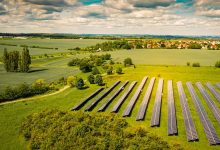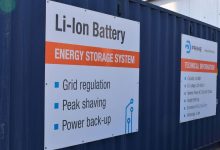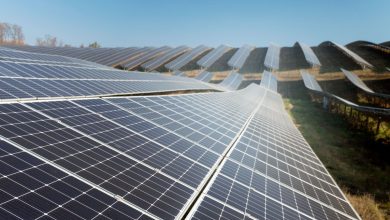World’s first grid-scale liquid air energy storage facility
The world’s first grid-scale liquid air energy storage (LAES) plant was officially launched by Highview Power on June 5 at Bury, near Manchester. The 5MW/15MWh LAES plant will become the first operational demonstration of LAES technology at grid-scale.
The LAES plant has been developed in partnership with recycling and renewable energy company, Viridor, and has been enabled in part by over £8m in funding from the UK government.
“We welcome the accomplishment of Highview Power, working together with their project site partner Viridor, to successfully build and operate this grid-scale liquid air energy storage technology demonstration plant,” Professor John Loughhead, Chief Scientific Advisor at BEIS stated. The deployment of smart, flexible technologies, such as energy storage, will help to ensure the UK has a secure, affordable and clean energy system now and in the future in keeping with the priorities within UK Government’s Modern Industrial Strategy. We’re pleased to have been able to support the Pilsworth demonstrator through our Energy Innovation Programme aimed at accelerating the commercialisation of innovative clean energy technologies and processes.”
“Support from Government, our partners and our supply chain, has enabled Highview Power to successfully design and build the world’s first grid-scale LAES plant here in the UK. The plant is the only large scale, true long-duration, locatable energy storage technology available today, at acceptable cost. The adoption of LAES technology is now underway, and discussions are progressing with utilities around the world who see the opportunity for LAES to support the transition to a low-carbon world,” Gareth Brett, CEO at Highview Power, mentioned.
After the launch, demand response aggregator KiWi Power will be able to draw energy from the LAES plant to power about 5,000 average-sized homes for around three hours. The plant will demonstrate how LAES can provide a number of reserve, grid balancing and regulation services. Yet the opportunity is far greater: LAES technology can scale to hundreds of Megawatts in line with the energy demand of urban areas the size of small towns up to large cities. This means that LAES plants could easily store enough clean electricity generated by a local windfarm to power a town like Bury (around 100,000 homes) for many days, not just a few hours.
“Liquid Air Energy Storage (LAES) technology is a great step forward in the creation of a truly de-centralised energy system in the UK allowing end-users to balance the national electricity network at times of peak demand. By drawing energy from a diverse range of low-carbon storage assets, companies can not only balance the grid but help meet rising energy demand and respond to changing patterns of consumption on a local and national level. Given the high uptake of renewable energy in the UK this is the technology that will allow the future grid to maintain system inertia and ensure the lights stay on. By investing in LAES technology companies will also be able to earn a predictable, annual, recurring revenue through the ancillary services with KiWi Power,” Yoav Zingher, CEO at KiWi Power Ltd, added.
With LAES technology now being proven at scale, the plant paves the way for the wider adoption of LAES technology globally. True long-duration energy storage is critical to enable the broader deployment of renewable energy; overcome the intermittency of solar and wind energy; help smooth peaks and troughs in demand; and provide the UK with a stable and secure source of homegrown energy.
In his turn, Richard Pennells, Managing Director, Energy at Viridor said: “Viridor, with its focus on transforming waste and harnessing all available environmental benefits through recycling and energy recovery, is pleased to have partnered Highview Power on this project at our Pilsworth Landfill site in Bury. Energy storage systems, such as the Highview project, offer the opportunity to store surplus electricity for use at times of high demand. The project at Pilsworth can also convert waste heat to power using the on-site gas engines. The innovative technology which has been developed through the Highview project could play an important role in supporting UK growth in low carbon, renewable energy sources and in maintaining the security of the United Kingdom’s electricity supply.”
LAES technology makes use of a freely available resource, the air, which is stored as a liquid and then converted back to a gas, involving an expansion process that releases stored energy. The turboexpander generator, manufactured by Baker Hughes, a GE company (BHGE), converts the energy of liquid into usable power. As the air expands, it flows through a turbine and spins it to generate electricity.
Because BHGE’s turboexpander can work with any gas, oil and gas companies have used the same technology for other purposes, including oil recovery, refinery and power generation. “It’s all the same concept,” explains Luca Maria Rossi, vice president of Industrial and Product Management Turbomachinery and Process Solutions at BHGE. “Air is a gas, and we have technology and engineering to unlock its power. Our unique experience in the oil and gas applications can perfectly support new technologies that facilitate the transition to a more sustainable energy mix.”
To warm the air, the Pilsworth plant uses waste heat from a neighbouring landfill gas power plant to which it is connected. Similarly, Highview Power plans to operate future LAES units off excess heat produced by ‘peaker’ plants. These power plants typically use natural gas turbines and spring into action when demand spikes.
No exotic metals or harmful chemicals are involved and the process does not release any carbon emissions. The plant comprises mostly of steel, which has a lifespan of between 30 to 40 years, in comparison with 10 years for batteries. At the end of life, a LAES plant can be decommissioned and the steel recycled. LAES plants can be located at the point of demand which makes them highly flexible and able to supply energy to help urban areas keep the lights on.
“The market opportunity for LAES technology is exciting – we estimate that 60% of the global energy storage market comprises long-duration, grid connected storage and that our LAES technology is ready to meet almost half of this (45%). The LAES plant in Bury has already played a key role in the breakthrough of LAES technology and will continue to do so. Utilities from around the world who have for some time been assessing our unique solution for their storage challenges, are now using the operating data to confirm their expectations. We are therefore already in detailed negotiations to build plants ten times the size of this one for utility customers of several nationalities and for various different applications,” Gareth Brett concluded.







